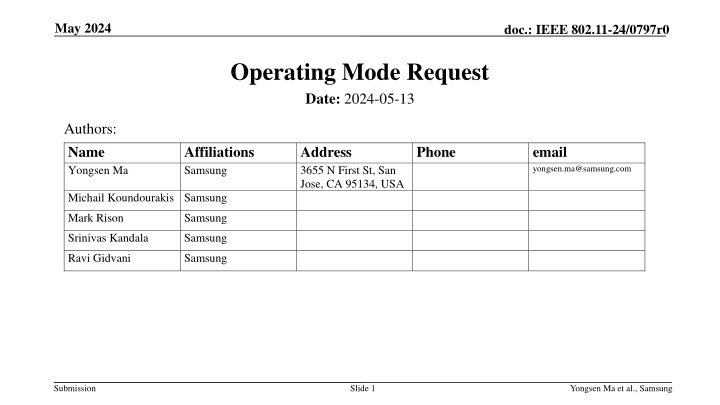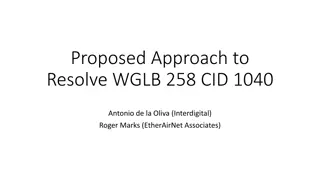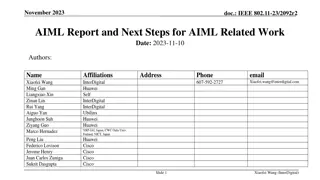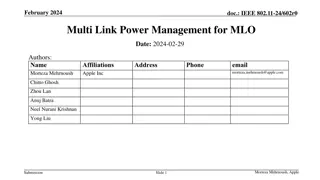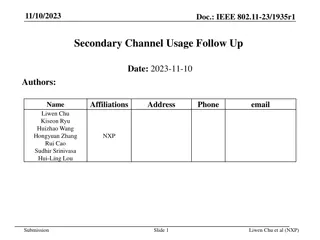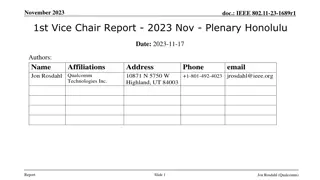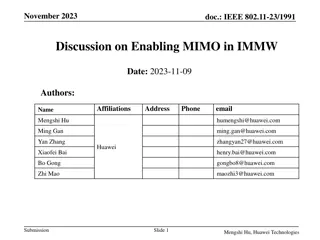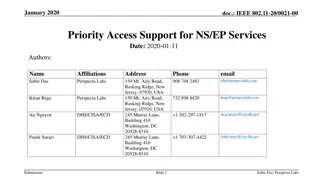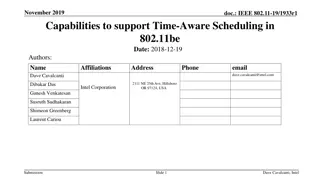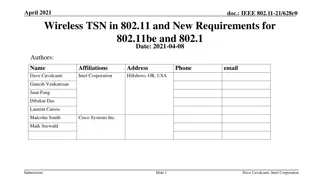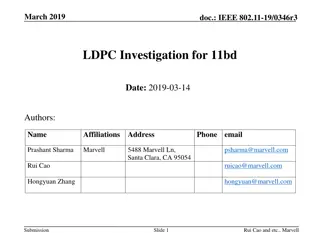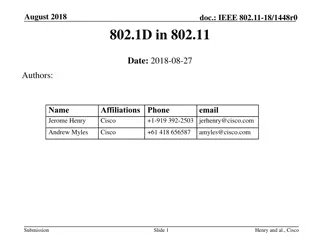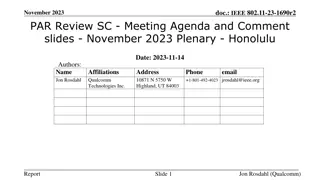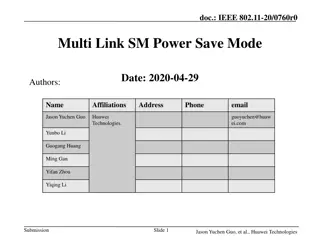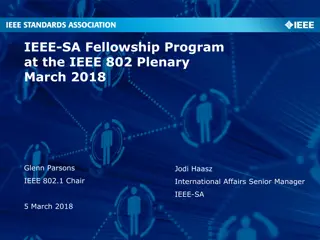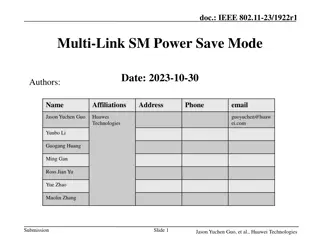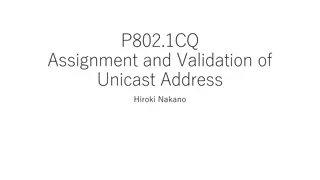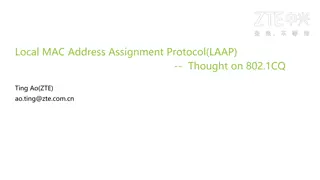IEEE 802.11-24/0797r0 Operating Mode Request
This document proposes an Operating Mode Request mechanism for STAs within the IEEE 802.11 standard. It allows a STA to request another STA to change its operating mode, such as bandwidth and number of spatial streams. The proposal outlines the reasons for making such requests and the acceptance/denial process by the responding STA.
Download Presentation

Please find below an Image/Link to download the presentation.
The content on the website is provided AS IS for your information and personal use only. It may not be sold, licensed, or shared on other websites without obtaining consent from the author.If you encounter any issues during the download, it is possible that the publisher has removed the file from their server.
You are allowed to download the files provided on this website for personal or commercial use, subject to the condition that they are used lawfully. All files are the property of their respective owners.
The content on the website is provided AS IS for your information and personal use only. It may not be sold, licensed, or shared on other websites without obtaining consent from the author.
E N D
Presentation Transcript
May 2024 doc.: IEEE 802.11-24/0797r0 Operating Mode Request Date: 2024-05-13 Authors: Name Yongsen Ma Affiliations Samsung Address 3655 N First St, San Jose, CA 95134, USA Phone email yongsen.ma@samsung.com Michail Koundourakis Samsung Mark Rison Samsung Srinivas Kandala Samsung Ravi Gidvani Samsung Submission Slide 1 Yongsen Ma et al., Samsung
May 2024 doc.: IEEE 802.11-24/0797r0 Abstract A STA may change its operating mode and notify other recipient STAs of a change in its operating mode. In addition to notifying other STAs of its own operating mode changes, a STA may want to request a second STA to run in a certain operating mode. This submission presents Operating Mode Request for such purpose. Submission Slide 2 Yongsen Ma et al., Samsung
May 2024 doc.: IEEE 802.11-24/0797r0 Introduction A STA may change its operating mode (BW, NSS) and notify other STAs by different mechanisms, for example [1] Operating Mode Indication (OM Control subfield, Transmit/Receive Operating Mode) Operating Mode Notification (OM field in OMN frame/element) (Extended) Channel Switch Announcement element (New Channel Number field -> BW) Notify Channel Width frames HT/VHT/HE/EHT Operation element [2] EML Operating Mode Notification [2] These mechanisms are used only for notification/indication purposes but not for request/negotiation of a certain Operating Mode among STAs. New requirement: A STA may request another STA to run in a certain Operating Mode e.g., multi-AP coordination (inter-BSS or inter-ESS), a STA asks the AP to change the AP s operating mode (BW/NSS, or any capable but disabled features) Submission Slide 3 Yongsen Ma et al., Samsung
May 2024 doc.: IEEE 802.11-24/0797r0 Proposal: Operating Mode Request An initiating STA may request a responding STA to change the responding STA s operating mode The operating mode may include BW, NSS, and maybe other settings/fields/elements The initiating STA may have different reasons for the Operating Mode Request for example the initiating STA has or will have certain changes (e.g., operating mode, network conditions or throughput/latency/QoS requirements) and requests the responding STA to change its operating mode (e.g., for better throughput, latency, QoS, etc.) The responding STA may have its own reasons to be running in certain operating mode and may accept or deny the Operating Mode Request. Submission Slide 4 Yongsen Ma et al., Samsung
May 2024 doc.: IEEE 802.11-24/0797r0 Operating Mode Request: Examples Non-AP STA to AP: a non-AP STA may request/recommend an AP to change the AP s operating mode, e.g., to increase the AP s BW/NSS if the AP is operating in low BW/NSS (maybe due to power save or interference). AP to AP: an AP (or non-AP) may request/recommend another AP to change its operating mode, e.g., to change the BW (or primary channel selection) to reduce/avoid interference on primary/non-primary channels or for other coordination. AP to non-AP STA: an AP may request/recommend a non-AP STA to change the non-AP STA s operating BW/NSS, e.g., due to power save, buffer status, or latency sensitive traffic. Non-AP STA to non-AP STA: a non-AP STA may request another non-AP STA to change its operating mode, e.g., based on conditions and requirements of the P2P and WLAN connections. Submission Slide 5 Yongsen Ma et al., Samsung
May 2024 doc.: IEEE 802.11-24/0797r0 Operating Mode Request: Options (1/2) Operating Mode Request (OMR) can be used as standalone or together with existing protocols such as OMI/OMN. The request may have different request types, e.g., recommend/demand a certain OM. The request may include a reason code, for example channel planning, coordinated spatial reuse and latency sensitive traffic, from the initiating/requesting STA. The request may be accepted or denied by the responding/recipient STA. usually the AP controls the BSS and STAs send OMN/OMI to inform other STAs that there are operating mode changes. A STA (AP or non-AP) may have its own reasons to decide on certain operating mode parameters. Submission Slide 6 Yongsen Ma et al., Samsung
May 2024 doc.: IEEE 802.11-24/0797r0 Operating Mode Request: Options (2/2) The request may be solicited or unsolicited, w/ or w/o the requirement of response frame ACK after the frame containing the OMR confirms the request was received. Response to the OMR indicates whether the responding/recipient STA accepts or denies the request. ACK/response may have options for explicit and implicit, i.e., if OMR is ACKed but the responder sends no OMI/OMN or any other related response frames then it means the responder has rejected the OMR. If the responding/recipient STA decides to accept the request, it sends an OMI or initiate an OMN procedure (in case of AP) with the updated OM (or other mechanisms such as Notify Channel Width and HT/VHT/HE/EHT Operation element). Submission Slide 7 Yongsen Ma et al., Samsung
May 2024 doc.: IEEE 802.11-24/0797r0 Operating Mode Request: Open Issues Solutions need to consider the following: Security and misuse concerns, e.g., a STA can manipulate others to keep changing their parameters (integrity check or encryption, such as proposed in MAC header protection [3,4,5]) Efficiency and scalability, should be compact Legacy STAs, back compatibility, fairness STAs in power save mode Consistency Submission Slide 8 Yongsen Ma et al., Samsung
May 2024 doc.: IEEE 802.11-24/0797r0 Conclusion This contribution presents Operating Mode Request/Response It allows an initiating STA to request a responding STA to change the responding STA s operating mode. The operating mode may include BW, NSS, and other parameters. The OM response could just be the existing signals/procedures, such as OMI, OMN, etc. The initiating/responding STA may be an AP, non-AP STA, AP MLD, or non-AP MLD. Submission Slide 9 Yongsen Ma et al., Samsung
May 2024 doc.: IEEE 802.11-24/0797r0 References [1] IEEE P802.11-REVme/D5.0, February 2024 [2] IEEE P802.11be/D5.0, November 2023 [3] IEEE 802.11-23/1997r1, MAC header protection, Po-Kai Huang (Intel) [4] IEEE 802.11-23/1888r1, MAC Header Protection - follow-up, Abhishek Patil (Qualcomm) [5] IEEE 802.11-24/0525r0, MAC header/data integrity with relaxed receiver requirement, Li-Hsiang Sun (Mediatek) Submission Slide 10 Yongsen Ma et al., Samsung
